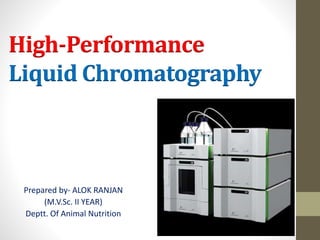HPLC
•Descargar como PPTX, PDF•
9 recomendaciones•871 vistas
HPLC basic principle, Introduction & working..
Denunciar
Compartir
Denunciar
Compartir

Recomendados
Recomendados
Más contenido relacionado
La actualidad más candente
La actualidad más candente (20)
Chiral chromatography & ion pair chromatography

Chiral chromatography & ion pair chromatography
GAS CHROMATOGRAPHY AND MASS SPECTROMETRY (GC-MS) BY P.RAVISANKAR.

GAS CHROMATOGRAPHY AND MASS SPECTROMETRY (GC-MS) BY P.RAVISANKAR.
Similar a HPLC
Similar a HPLC (20)
Types Of Chromatography - liquid & Gas Chromatography(Mobile Phase).pptx

Types Of Chromatography - liquid & Gas Chromatography(Mobile Phase).pptx
High Performance Liquid Chromatography-HPLC slide.ppt

High Performance Liquid Chromatography-HPLC slide.ppt
Applied Chemistry Necessary for Chemical Engineers.pptx

Applied Chemistry Necessary for Chemical Engineers.pptx
HIGH PERFORMANCE LIQUID CHROMATOGRAPHY/SAGAR/SHARMA/DEPARTMENT OF PHARMACEUTI...

HIGH PERFORMANCE LIQUID CHROMATOGRAPHY/SAGAR/SHARMA/DEPARTMENT OF PHARMACEUTI...
Último
This presentation was provided by William Mattingly of the Smithsonian Institution, during the fourth segment of the NISO training series "AI & Prompt Design." Session Four: Structured Data and Assistants, was held on April 25, 2024.Mattingly "AI & Prompt Design: Structured Data, Assistants, & RAG"

Mattingly "AI & Prompt Design: Structured Data, Assistants, & RAG"National Information Standards Organization (NISO)
Último (20)
Mattingly "AI & Prompt Design: Structured Data, Assistants, & RAG"

Mattingly "AI & Prompt Design: Structured Data, Assistants, & RAG"
Basic Civil Engineering first year Notes- Chapter 4 Building.pptx

Basic Civil Engineering first year Notes- Chapter 4 Building.pptx
This PowerPoint helps students to consider the concept of infinity.

This PowerPoint helps students to consider the concept of infinity.
Measures of Central Tendency: Mean, Median and Mode

Measures of Central Tendency: Mean, Median and Mode
Seal of Good Local Governance (SGLG) 2024Final.pptx

Seal of Good Local Governance (SGLG) 2024Final.pptx
Z Score,T Score, Percential Rank and Box Plot Graph

Z Score,T Score, Percential Rank and Box Plot Graph
Unit-V; Pricing (Pharma Marketing Management).pptx

Unit-V; Pricing (Pharma Marketing Management).pptx
ICT Role in 21st Century Education & its Challenges.pptx

ICT Role in 21st Century Education & its Challenges.pptx
HPLC
- 1. High-Performance Liquid Chromatography Prepared by- ALOK RANJAN (M.V.Sc. II YEAR) Deptt. Of Animal Nutrition
- 2. Chromatography Chromatography was discovered in 1903 and was used to separated plant pigments . It is a popular method used to separate mixtures to their individual components.
- 4. Scope • The history of HPLC began in the 60’s and was known as high pressure liquid chromatography. • The instrumentation and columns improved over the time and it is now known as high performance liquid chromatography. • HPLC separation technique provides high speed, efficiency and high sensitivity as compared to liquid chromatography. • A very small volume of sample is injected into a tube packed with a stationary phase (3-5 microns particles). • The sample is pushed down the column with a mobile phase by applying high pressure and the components are detected and quantified as they exit the column.
- 5. Introduction • A popular analytical technique used for the separation, identification and quantification • solvent usually flows through column but here,solvents are forced. • solvent will be forced under high pressures upto 400 atmospheres so that sample can be separated • Chromatography can be depicted as a mass exchange process including adsorption • the adsorbent, is regularly a granular material made of solid particles (e.g. silica, polymers, etc.) 2 μm to 50 μm in size • pressurized fluid is commonly a blend of solvents (e.g. water, acetonitrile and/or methanol) and is known as ‘mobile phase’
- 6. • (HPLC depends on pumps to pass a pressurized fluid and an example blend through a section loaded with adsorbent, prompting the partition of the specimen segments.) • -The pressurized fluid is commonly a blend of solvents (e.g. water, acetonitrile and/or methanol) and is known as ‘mobile phase’. • Its organization and temperature plays an important part in the partition procedure by affecting the connections occurring between sample segments and adsorbent
- 7. Components of HPLC 1. Pump: pumps the mobile phase at a specific flow rate in mL/min. The pump pressure is normally between 400-600 bar. 2. Injector: Introduces the sample into the column (about 5-20 μL). 3. Column: provides separation through high pressure created by the small particles. 4. Detector: it quantifies and identify the sample components and provides information to the computer. 5. Computer: takes the signals from the detector and displays the retention times and quantity of the components.
- 8. Principle of HPLC • The process involves interaction of compounds in the analyte (which travels along the mobile phase ) across an immobile surface(stationary phase). • The compounds bind at the specific regions of stationary phase based on certain physical and chemical properties. • This bound molecules are then eluted with a suitable buffer and are the same collected with time. • The more polar compounds adsorbed with silica i.e. stationary phase, Hence move slowly while compounds with hydrophobic nature doesn’t bind with stationary phase, Hence moves faster & comes out first and displays its graph.